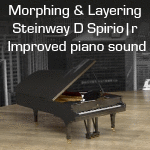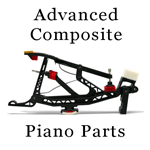 |
Welcome to the Piano World Piano Forums
Over 3 million posts about pianos, digital pianos, and all types of keyboard instruments.
Over 100,000 members from around the world.
Join the World's Largest Community of Piano Lovers
(it's free)
It's Fun to Play the Piano ... Please Pass It On!
|
|
|
|
34 members (Erik Beginner, Emily2Lame, Candywoman, CharlesXX, Bett, akdor1154, CyberGene, 7 invisible),
337
guests, and
513
robots. |
|
Key:
Admin,
Global Mod,
Mod
|
|
|
|
Joined: Jan 2004
Posts: 2,227
2000 Post Club Member
|
OP

2000 Post Club Member
Joined: Jan 2004
Posts: 2,227 |
PianoMeter is a tuning app rebranded from Easy Piano Tuner. There is a long thread here with a lot of the background if you want.... http://forum.pianoworld.com/ubbthre.../using-easy-piano-tuner.html#Post2727233I've been using the pro version for a while - I was mostly interested in the "smart" overpull features - Just quickly measuring a few notes/octave generates an overpull approach that has been working out really well for me. I like that the overpull is set without having the app "hear" where each note is to start - it really speeds up the note-switching. I did delve into the custom stretch controls a bit and have found a combination that matches my favorite custom stretch using the Verituner. (I can share that if interested.) Anyone else done more than just use the default, or built-in stretch parameters? I do also use my really mild well-temperament, and PianoMeter lets me put that in as a custom temperament as well. As a long-time "needle-gazer", it took some personal retraining to interpret the strobe dial - which is recommended as the better display except for the high treble. Nice work developing a powerful newer piano tuning app! (He drops in here from time to time and is usually quick to respond to questions.) Ron Koval
|
|
|
|
|
Joined: Jun 2006
Posts: 1,550
1000 Post Club Member
|

1000 Post Club Member
Joined: Jun 2006
Posts: 1,550 |
Thanks very much Ron!
Yes I would like to see your custom stretch.
I like the pitch raise function of tunelab for the same reason as you stated with PianoMeter. Taking samples before tuning.
Do you prefer using PianoMeter over tunelab for pitch raises?
Thank you again!
Jean
|
|
|
|
|
Joined: Jan 2004
Posts: 2,227
2000 Post Club Member
|
OP

2000 Post Club Member
Joined: Jan 2004
Posts: 2,227 |
Yes, I prefer PianoMeter's pitch raise --- so far!
Mostly because I can get the first pass to closely match my preferred Verituner setting - I'm still fine-tuning my better pianos with Verituner, I'm more accustomed to the display and stability of the needle. I will be testing the margin of error using the strobe vs the Verituner display. Not sure if there will be any measurable difference yet.
For a universal style that closely matches my preferred style change the default settings to: (the numbers are on a slider and hard to control, so just get close!)
Octave 8.93 - then open the octave arrow to set:
2:1 8.93
4:2 8.56
6:3 6.06
8:4 2.06
10:5 2.03
12th 4.49
3:1 4.49
6:2 2.58
9:3 1.51
Double octave 4.82
4:1 4.82
8:2 2.17
19th stays the same 1.0
Triple octave .31
5th 3.00
4th 1.00
no extra treble or bass stretch
Let me know how it works if you give it a try!
I have the inharmonicity weight factor at .95, so make sure to double check any notes that look out of place on the inharmonicity graph and lock the tuning when you have them where they seem to belong.
Ron Koval
|
|
|
|
|
Joined: Jun 2006
Posts: 1,550
1000 Post Club Member
|

1000 Post Club Member
Joined: Jun 2006
Posts: 1,550 |
Thanks!
I input your numbers and saved it. I have a few tunings tomorrow so will try it out. ( Those sliders sure are hard to control!)
Thanks again!
Jean
|
|
|
|
|
Joined: May 2013
Posts: 2,851
2000 Post Club Member
|

2000 Post Club Member
Joined: May 2013
Posts: 2,851 |
Ron,
Thanks for posting your data with which I will experiment. I don't understand what the inharmonicity weight factor does?
My occasional problem is PianoMeter jumping to a note of a higher partial even if it is set to step mode. I wish there was a warning when this happens as I don't always realise why the tuning gets difficult!
Also do you know why the app needle and strobe jumps around when there is no sound input?
Ian
I'm all keyed up
2016 Blüthner Model A
|
|
|
|
|
Joined: Jan 2004
Posts: 2,227
2000 Post Club Member
|
OP

2000 Post Club Member
Joined: Jan 2004
Posts: 2,227 |
Inharmonicity weight factor tells the app how much to relate the actual data to driving the calculation. A higher number means the data drives the calculation rather than a smooth inharmonicity curve model. A smaller number means the program will smooth out the data closer to the model of a curve. Great if you are hoping to react to bumps in stringing scales, not so good if your data isn't very good!
If you use a higher number, you must be sure to review the inharmonicity curve and remeasure or just play single strings of those that look out of place to verify the repeatability of that data. Anthony posted some graphs showing how the app treats that kind of data on that other long thread and I believe they are on the PianoMeter website as well.
Interesting thing about the filtering of our brains... we might be listening for just piano tones, but the apps hear what's going on in the room, leading to the app trying to determine the pitch of voices, heating systems, lawn mowers etc...
So far, I've had better luck than you with the app staying on the right note. It is a problem I've noticed with other apps as well. It's always good to keep an eye on the keyboard and note name in the middle of the screen!
Ron Koval
|
|
|
|
|
Joined: Jan 2004
Posts: 2,227
2000 Post Club Member
|
OP

2000 Post Club Member
Joined: Jan 2004
Posts: 2,227 |
Also, I just heard back that the inharmonicity data gathering averages all of new keystrokes on a single note. If you want to get a "fresh start" press and hold the red keyboard bar (not in pitch raise mode) and it will clear data on that note allowing you to try again. As more data is gathered on a single note, the dot should become more stable.
Ron Koval
|
|
|
|
|
Joined: May 2013
Posts: 2,851
2000 Post Club Member
|

2000 Post Club Member
Joined: May 2013
Posts: 2,851 |
Ron,
thanks for all that. I find it strange that after I complete a fine tuning the piano sound fine to my ears. However when I post an MP4 video made using a synched wav file I hear stretch issues at both low and high end. Perhaps this is because I'm not at the piano as when I'm tuning or playing?
Ian
I'm all keyed up
2016 Blüthner Model A
|
|
|
|
|
Joined: Jan 2014
Posts: 284
Full Member
|

Full Member
Joined: Jan 2014
Posts: 284 |
Ron, Thank you for posting these numbers here. This is the deepest I've seen anyone dive into the custom styles yet. Comparing this to the "default" style for a few saved tunings, it looks like your style reduces the stretch somewhat in the treble and increases it slightly in the low bass. The reduced treble stretch is probably due mostly to the high 2:1 octave weight. I'm a bit curious about the low triple-octave weight. I like the triple octave as a tuning interval because I think it helps ensure the piano stays consonant (is that the right word?) on the larger scale. @Beemer, here's a link to the explanation of the "weight factor". Ron explained it well, but the graph is helpful I think. https://pianometer.com/support/#Inharmonicity_weight_factor![[Linked Image]](https://pianometer.com/wp-content/uploads/2018/09/Inharmonicity-and-weighted-averages-with-notation.png) The dots are what is measured, the black line is a "best fit", and the colored lines are the compromise that the app actually uses to calculate the tuning.
|
|
|
|
|
Joined: May 2013
Posts: 2,851
2000 Post Club Member
|

2000 Post Club Member
Joined: May 2013
Posts: 2,851 |
Anthony,
Thanks for that. I'm still getting great satisfaction from using and recommending your PianoMeter.
Ian
I'm all keyed up
2016 Blüthner Model A
|
|
|
|
|
Joined: Jan 2004
Posts: 2,227
2000 Post Club Member
|
OP

2000 Post Club Member
Joined: Jan 2004
Posts: 2,227 |
Anthony, I have found some pianos where the 8th partials are VERY high, pushing the treble way outside of the single and double octave if the triple octave is weighted. Seems like the double octave and 12th is a better rough guide for making sure octaves have a better chance of working better together. (or at least all of them off a bit, but workable!)
But yes, a bit deeper in the bass and less stretched up top compared to the default works to my liking.
Ron Koval
|
|
|
|
|
Joined: Jul 2003
Posts: 27
Full Member
|

Full Member
Joined: Jul 2003
Posts: 27 |
The sliders are difficult to set exactly. You can numerically add the custom stretch values by tapping the drop down arrow for Octave, Twelfth, etc. and then tapping on the existing stretch value on the right side of the screen for 2:1, 4:2, 6;3, etc. for each interval you want to adjust.
Enter the custom stretch value and then save. I am using Android. I don't know if it works the same for iOS.
Brent Musgrave
Piano Tuner-Technician
|
|
|
|
|
Joined: Jan 2004
Posts: 2,227
2000 Post Club Member
|
OP

2000 Post Club Member
Joined: Jan 2004
Posts: 2,227 |
Thanks - I figured there must be something like that! I was just going by trial and error, so I'm sure rounding off the numbers will be fine!
In other words, there isn't anything magical about the specific numbers I posted....
Ron Koval
|
|
|
|
|
Joined: Jul 2003
Posts: 27
Full Member
|

Full Member
Joined: Jul 2003
Posts: 27 |
I'm going to try your custom stretch on a Baldwin studio. Any predictions or past experience using your custom stretch on a small piano?
Brent Musgrave
Piano Tuner-Technician
|
|
|
|
|
Joined: Jan 2014
Posts: 284
Full Member
|

Full Member
Joined: Jan 2014
Posts: 284 |
The sliders are difficult to set exactly. You can numerically add the custom stretch values by tapping the drop down arrow for Octave, Twelfth, etc. and then tapping on the existing stretch value on the right side of the screen for 2:1, 4:2, 6;3, etc. for each interval you want to adjust.
Enter the custom stretch value and then save. I am using Android. I don't know if it works the same for iOS. Whoops, that hasn't made it into the iOS version yet. I'll get it into the next release.
|
|
|
|
|
Joined: May 2019
Posts: 83
Full Member
|

Full Member
Joined: May 2019
Posts: 83 |
Hi Ron!
It would be nice if you posted the same instructional video on your YouTube channel as for Verituner. Thanks in advance!
|
|
|
|
|
Joined: Jan 2004
Posts: 2,227
2000 Post Club Member
|
OP

2000 Post Club Member
Joined: Jan 2004
Posts: 2,227 |
I'm going to try your custom stretch on a Baldwin studio. Any predictions or past experience using your custom stretch on a small piano? Check the inharmonicity graph, remeasure as needed and lock the tuning before the final tuning. Let us know how it goes! You actually want to see bumps in the graph at stringing breaks or even sometimes as the wire gauge changes. The hope is that with precise data, the octaves can sound "better" than some of the other platforms that only sample a few notes. My focus has always been on octaves before other intervals - perhaps from my previous musical life as an orchestral bassoonist or as a singer in a choir. While piano techs are trained to fuss over rapidly beating intervals to confirm their tuning style choices, I have found that musicians will often first point out problems with unisons and octaves as a tuning sours... Ron Koval
|
|
|
|
|
Joined: Jan 2004
Posts: 2,227
2000 Post Club Member
|
OP

2000 Post Club Member
Joined: Jan 2004
Posts: 2,227 |
Since every piano I see is new to PianoMeter, here is my quick-start:
1. Select new tuning, enter data in tuning settings.
2. Play a single string of A4 and then A3 to get an idea of where the pitch is to start. (and start getting quality inharmonicity measurements into the app)
3. Adjust offset if desired - I will tune many home pianos with low humidity this time of year at A=439 or 441 during high humidity season.
4. Enter pitch raise data - I use C#, F#, and A# for my selected sample notes - fits under the hand easily and doesn't go all the way to either end of the keyboard. I usually don't worry about playing single strings at this point.
5. Start pitch raise at bottom of the long bridge and go to the top. Finish with the bass going down.
6. Study and remeasure notes if needed using the inharmonicity graph. You are looking for outliers - those notes that divert from the curve by a bunch. Lock the tuning.
7. Fine tuning pass using whatever order you prefer.
Ron Koval
|
|
|
|
|
Joined: Jun 2006
Posts: 1,550
1000 Post Club Member
|

1000 Post Club Member
Joined: Jun 2006
Posts: 1,550 |
Thanks Ron,
I really like the idea of using C#, F#, and A# for sample notes. I was using C, E and G#, basically splitting the octaves in thirds, but C8 was useless.
I tried your tuning yesterday on a kawai studio and really liked the result. This was for a school that has 3 more that I need to do next week. I will. try the default on another and a pure twelph on another as well and then compare.
Thanks very much again!
|
|
|
|
|
Joined: Jan 2004
Posts: 2,227
2000 Post Club Member
|
OP

2000 Post Club Member
Joined: Jan 2004
Posts: 2,227 |
Anyone else had any luck?
My perception is still that determining between the slow movement of particular partial strobes to the left and the slow motion to the right takes a lot more time than I'm used to when used for fine-tuning. It also seems that there might be a bit more "plus or minus" a half-cent to a cent introduced during the tuning process because of the display.
Still, PianoMeter is working very well as a pitch-raising first pass. I'm accustomed to doing two passes on just about every piano here in the midwest, so it has been appreciated!
Ron Koval
|
|
|
|
Forums42
Topics205,318
Posts3,065,307
Members100,657
| |
Most Online15,252
Mar 21st, 2010
|
|
|
|
|
|

|















![[Linked Image]](https://pianometer.com/wp-content/uploads/2018/09/Inharmonicity-and-weighted-averages-with-notation.png)









